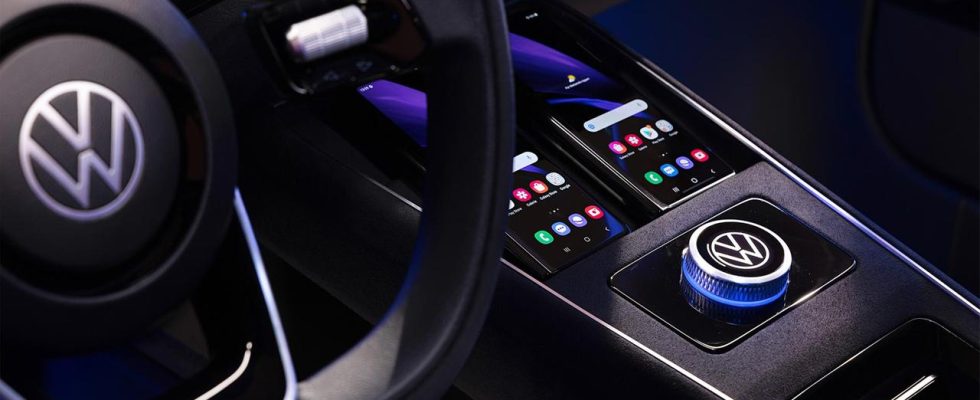VW has apparently taken the constant criticism from its customers to heart. Fewer touchscreens, more buttons – with the ID.2 electric car, drivers should be able to find their way around the cockpit more easily again.
A futuristic interior design and a large infotainment screen – drivers at VW should feel like they are in a Tesla, according to the vision of former Volkswagen boss and self-confessed Musk fan Herbert Diess. The only drawback: Many VW drivers didn’t want to feel like that. The touch controls were not well received by customers at all. Apparently there was a great longing for the buttons and keys of earlier days.
For all interior nostalgics, there is now good news, at least at first glance: physical buttons, knobs, dials – they are all set to make a comeback at the Wolfsburg-based car company. VW has now shown what this should look like with the ID.2 model. In the small electric SUV, drivers should be able to switch some functions on and off manually and further adjust them using a rotary control. These include the volume, air conditioning and fans.
“A lot of damage” for the VW brand
But it will still take a while until that happens. The entry-level electric car ID.2all will not go into series production until 2025. Until then, VW drivers will have to make do with touchscreens or even unlit sliders in many cars – from the ID.3 to the Tiguan.
And even with the ID.2 there is no complete move away from displays: VW continues to rely on digital displays for speed, charging status and entertainment system.
In the ID2.all there are still numerous displays – but also buttons and rotary controls.
VW brand boss Thomas Schäfer had already admitted in June in an interview with the British platform “Autocar” that the new interior concept had “definitely caused a lot of damage”.
Herbert Diess – a Tesla fan
Schäfer’s predecessor and former CEO Herbert Diess, a great admirer of Elon Musk, was responsible for this interior concept. Diess once said about the Tesla boss: “You have to take him very seriously. He anticipates the future.”
Diess repeatedly praised the advantages of the US electric car manufacturer to executives and sought closeness to Musk at personal meetings. In the past, both managers have repeatedly exchanged pleasantries publicly and praised each other for being serious about e-mobility.
A selfie with the Tesla boss – a highlight for the then VW boss and Musk fan Diess.
Drivers should find their way around easily
The new VW CEO Oliver Blume has also stuck to his commitment to electromobility. But customers should apparently get the feeling that they are actually driving a VW, at least in the interior – there is no risk of confusion.
Getting in and finding your way directly in the car is what will be required of VW cars in the future. Volkswagen has always been good at setting up vehicles so that users intuitively know what is hidden where, brand boss Schäfer told Autocar. Therefore, the placement of the controls should not change from model to model in the future.
When the display becomes a risk
Moving away from Tesla’s design philosophy could have another advantage in addition to increased customer satisfaction: it could make driving a VW safer again. At least that’s what numerous studies suggest. Operating via touch display or searching for functions in menus and submenus inevitably leads to the driver losing sight of what is happening on the road. And for a dangerously long time.
According to a study by the British Research Institute for Road Safety TRL, drivers’ reaction times when using a touch display increase by 57 percent. For comparison: under the influence of cannabis it is 21 percent, while talking on the phone with a cell phone to the ear 46 percent.
Dangerously long blind flight
Touch displays therefore represent a significant safety risk. The ADAC also came to this conclusion in a study. Accordingly, the operating times in modern cars with touch displays for everyday tasks such as switching on the low beam or adjusting the interior temperature were up to eight seconds.
Eight seconds of distraction can have disastrous consequences: at a recommended speed of 130 km/h on the motorway, it means flying blind for almost 290 meters.
There is a risk of a 100 euro fine and one point in Flensburg
What many drivers don’t know: According to Section 23 of the Road Traffic Act (StVO), only fleeting glances at touchscreens are permitted while driving. “Longer periods of averting your gaze” are explicitly prohibited. If a driver is caught using the vehicle illegally, he will have to pay a fine of 100 euros and will also receive one point in Flensburg.
Traffic safety experts therefore clearly recommend that car manufacturers install separate buttons in their models for low-distraction operation, at least for frequently used vehicle functions – such as windshield wipers, driving lights, temperature adjustment and seat heating.
But given the multitude of functions that modern cars offer today, it also seems clear that there is unlikely to be a complete return to the interior designs of days gone by. The days when drivers could press a separate button, turn a separate knob or move a separate lever for each operating function are probably irretrievably over.

